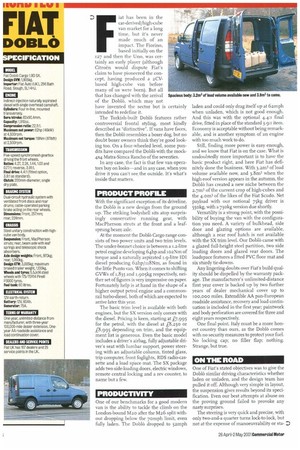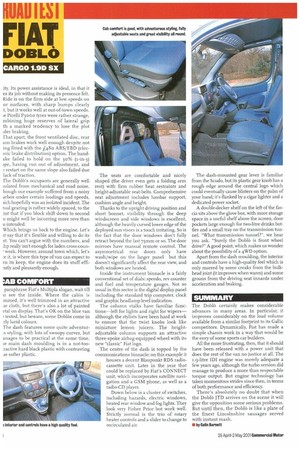iat has been in the car-derived/high-cube van market for a
Page 26

Page 28

If you've noticed an error in this article please click here to report it so we can fix it.
long time, but it's never made much of an impact The Florin°, based initially on the 127 and then the Uno, was certainly an early player (although Citroen would dispute Fiat's claim to have pioneered the concept, having produced a 2CVbased high-cube van before many of us were born). But all that has changed with the arrival of the Doblo, which may not have invented the sector but is certainly intended to redefine it.
The Turkish-built Dobla features rather controversial frontal styling, most kindly described as -distinctive". If vans have faces, then the Doblo resembles a boxer dog, but no doubt boxer owners think they're good looking too. On a four-wheeled level, some pundits have compared the Doble with the mock4x4 Matra-Simca Rancho of the seventies.
In any case, the fact is that few van operators buy on looks—and in any case, when you drive it you can't seethe outside. It's what's inside that matters.
PRODUCT PROFILE
With the significant exception of its driveline, the DoblO is a new design from the ground up. The striking bodyshell sits atop surprisingly conservative running gear, with MacPherson struts at the front and a leafsprung beam axle.
At the moment the DoblO Cargo range consists of two power units and two trim levels. The under-bonnet choice is between a i.2-litre petrol engine developing 64hp and io2Nm of torque and a naturally aspirated 1.9-litre ID1 diesel producing 62hp/118Nm, as found in the little Punto van. When it comes to shifting GVWs of 1,835 and 1,905kg respectively, neither set of figures is very impressive on paper. Fortunately help is at hand in the shape of a higher output petrol engine and a commonrail turbo-diesel, both of which are expected to arrive later this year.
The basic trim level is available with both engines, but the SX version only comes with the diesel. Pricing is keen, starting at £7,995 for the petrol, with the diesel at L8,25o or L8,995 depending on trim, and the equipment list is generous. Even the basic model includes a driver's airbag, fully adjustable driver's seat with lumbar support, power steering with an adjustable column, tinted glass, trip computer, front foglights, RDS radio-cassette and a load space mat. The SX package adds two side-loading doors, electric windows, remote central locking and a rev counter, to name but a few.
PRODUCTIVITY
One of our benchmarks for a good modern van is the ability to tackle the climb on the London-bound M20 after the M26 split without dropping below the 70mph limit, even fully laden. The Dob16 dropped to 52mph laden and could only drag itself up at 62niph when unladen, which is not good enough. And this was with the optional 4.4:1 final drive, fitted in place of the standard 3.9:1 item. Economy is acceptable without being remarkable, and is another symptom of an engine with too much work to do.
Still, finding more power is easy enough, and we know that Fiat is on the case. What is undoubtedly more important is to have the basic product right, and here Fiat has definitely done the business. With 3.2m3 of load volume available now, and 3.8m3 when the high-roof version appears in the autumn, the Dobln has created a new niche between the 2.7m3 of the current crop of high-cubes and the 4.om3 of the likes of the Fiat Scudo. Net payload with our notional 75kg driver is 55okg, with a 730kg version due shortly.
Versatility is a strong point, with the possibility of buying the van with the configuration you need. A variety of bulkhead, side door and glazing options are available, although a rear roof hatch is not available with the SX trim level. Our Dahl° came with a glazed full-height steel partition, two side loading doors and glazed rear doors. The loadspace features a fitted PVC floor mat and six sturdy tie-downs.
Any lingering doubts over Fiat's build quality should be dispelled by the warranty package. The manufacturer's unlimited-distance first year cover is backed up by two further years of dealer mechanical cover up to 100,000 miles. Extendible AA pan-European roadside assistance, recovery and load continuation is included in the first year; paintwork and body perforation are covered for three and eight years respectively.
One final point. Italy must be a more honest country than ours, as the Doblb comes with no security measures to protect your fuel. No locking cap; no filler flap; nothing. Strange, but true.
ON THE ROAD
One of Fiat's stated objectives was to give the Dobla, similar driving characteristics whether laden or unladen, and the design team has pulled it off. Although very simple in layout, the suspension gives results beyond its specification. Even our best attempts at abuse on the proving ground failed to provoke any nasty surprises.
The steering is very quick and precise, with only two-and-a quarter turns lock-to-lock, but not at the expense of manoeuvrability or sta
ity. Its power assistance is ideal, in that it es its job without making its presence felt. Ride is on the firm side at low speeds on or surfaces, with sharp bumps clearly t, but it works well at out-of-town speeds. Le Pirelli P3 00o tyres were rather strange, mbining huge reserves of lateral grip th a marked tendency to lose the plot Lder braking.
That apart, the front ventilated disc, rear urn brakes work well enough despite not ing fitted with the L48o ABS/ EBD (elec)nic brake distribution) option. The handake failed to hold on the 30% (1-in-3) )pe, having run out of adjustment, and restart on the same slope also failed due lack of traction.
The DoblO's occupants are generally well misted from mechanical and road noise, hough our example suffered from a noisy arbox under certain loadings and speeds, iich hopefully was an isolated incident. The tual gearing is rather widely spaced, to the int that if you block shift down to second u might well be incurring more revs than u intended.
Which brings us back to the engine. Let's st say that it's flexible and willing to do its st. You can't argue with the numbers, and ,hp really isn't enough for laden cross-coun, work. However, around town which, let's :e it, is where this type of van can expect to m its keep, the engine does its stuff effimtly and pleasantly enough.
AB COMFORT
paraphrase Fiat's Multipla slogan, wait till u see the inside. Where the cabin is mmed, it's well trimmed in an attractive azcloth, but there's also a lot of painted etal on display. That's OK on the blue van tested, but beware, some Doblos come in rly lurid colours.
The dash features some quite adventurLs styling, with lots of swoopy curves, but anages to be practical at the same time. le main dash moulding is in a not-too.ractive hard black plastic with contrasting J.e softer plastic. The seats are comfortable and nicely shaped (the driver even gets a folding arm rest) with firm rubber heat restraints and height-adjustable seat-belts. Comprehensive seat adjustment includes lumbar support, cushion angle and height.
Thanks to the upright driving position and short bonnet, visibility through the deep windscreen and side windows is excellent, although the heavily curved lower edge of the deployed sun visors is a touch irritating. So is the fact that the door windows don't fully retract beyond the last 75mm or so. The door mirrors have manual remote control. The asymmetrical rear doors only have wash/wipe on the larger panel but this doesn't significantly affect the rear view, and both windows are heated.
Inside the instrument binnacle is a fairly conventional set of dials: speedo, rev counter and fuel and temperature gauges. Not so usual in this sector is the digital display panel including the standard trip computer, clock and graphic headlamp level indication.
The column stalks have familiar functions—left for lights and right for wipers— although the stylists have been hard at work to ensure that the twist knobs look like miniature lemon juicers. The heightadjustable column supports an attractive three-spoke airbag-equipped wheel with its new "classic" Fiat logo.
The centre of the dash is topped by the communications binnacle; on this example it houses a decent Blaupunkt RDS radiocassette unit. Later in the year that could be replaced by Fiat's CONNECT unit, which incorporates satellite navigation and a GSM phone, as well as a radio-CD player.
Down below is a cluster of switches, including hazards, electric windows, heated rear window and fog lights. They look very Fisher Price but work well. Strictly normal is the trio of rotary heater controls and a slider to change to recirculated air.
The dash-mounted gear lever is familiar from the Scudo, but its plastic gear knob has a rough edge around the central logo which could eventually cause blisters on the palm of your hand; it's flanked by a cigar lighter and a dedicated power socket.
A double-decker shelf on the left of the fascia sits above the glove box, with more storage space in a useful shelf above the screen, door pockets large enough for two-litre drinks botties and a small tray on the transmission tunnel, "What transmission tunnel?", we hear you ask. "Surely the Dobla is front wheel drive?" A good point, which makes us wonder about the possibility of a 4WD option.
Apart from the dash moulding, the interior and controls have a high-quality feel which is only marred by some creaks from the bulkhead joint (it improves when warm) and some groans from the driving seat innards under acceleration and braking.
SUMMARY
The Dobla certainly makes considerable advances in many areas. In particular, it improves considerably on the load volume available from a similar footprint to its Gallic competitors. Dynamically, Fiat has made a simple chassis work in a way that would be the envy of some sports car builders.
All the more frustrating, then, that it should have been released with a power unit that does the rest of the van no justice at all. The r.9-litre IDI engine was merely adequate a few years ago, although the turbo version did manage to produce a more than respectable torque output. But engine technology has taken momentous strides since then, in terms of both performance and efficiency.
There's absolutely no doubt that when the Dobla ITD arrives on the scene it will give the opposition some serious problems. But until then, the Roble) is like a plate of the finest Lincolnshire sausages served with instant mash.
by Coin Barnett
































































































